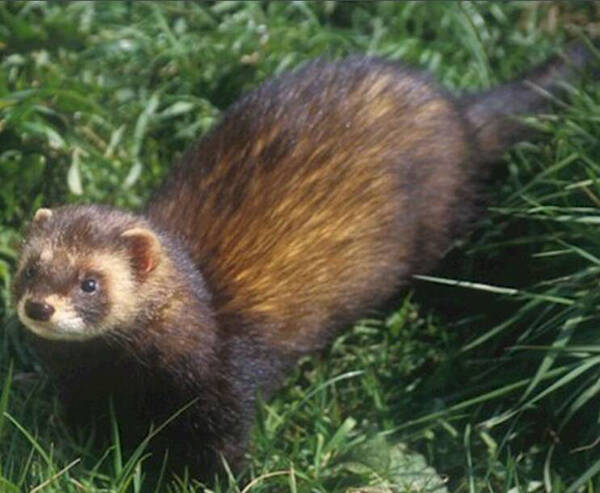Mustela putorius
IUCN
LCBasic Information
Scientific classification
- name:Mustela putorius
- Scientific Name:Mustela putorius,Western Polecat、European Polecat,European weasel, western weasel
- Outline:Carnivora
- Family:mustelidae mustelae genus
Vital signs
- length:35-51cm
- Weight:700-1400g
- lifetime:About 10 years
Feature
The back of the body has black fur, a white cheek, and black in between.
Distribution and Habitat
Origin: Albania, Andorra, Austria, Belarus, Belgium, Bosnia and Herzegovina, Bulgaria, Croatia, Czech Republic, Denmark, Estonia, Finland, France, Germany, Gibraltar, Greece, Hungary, Italy, Latvia, Liechtenstein, Lithuania, Luxembourg, Macedonia, Moldova, Montenegro, Netherlands, Norway, Poland, Portugal, Romania, Russian Federation, Serbia, Slovakia, Slovenia, Spain, Sweden, Switzerland, Turkey, Ukraine, United Kingdom.
Origin unknown: Algeria, Morocco.
The wood weasel inhabits lowlands, usually below 500 meters above sea level. In swamps, forests, wooded areas, plantations, river banks, sand dunes, sea cliffs and near farm buildings.
Appearance
The head and body length of the forest weasel is 35-51 cm, and the tail length is 12-19 cm; its weight is 0.7-1.4 kg. It has a slender body, a broad head and short limbs of the same species. Showing extreme sexual dimorphism, males are up to twice as heavy as females, but apart from body size they are roughly identical in appearance, with a raccoon-like black mask surrounding their eyes surrounded by a white face. The white ears are short and round. Sensitive sense of smell and hearing. The canine teeth are more developed and the cleft teeth are smaller; the upper molars are arranged horizontally, and the inner leaves are wider than the outer leaves; the crown diameter of the molars is greater than the height of the outer incisors. It has black fur on its body, with soft body hair and no markings. In winter, the coat is thick and shiny, but in summer it is thinner and appears faded. Both front and rear feet have 5 fingers (toes); semi-plantar; claws are sharp and non-retractable. The t
Details
The forest weasel (scientific name: Mustela putorius) is also known as Western Polecat and European Polecat in foreign languages. There are 7 subspecies in total.

Most forest weasels are solitary creatures, prefer to live alone, and have a strong sense of territory. They act alone, appear in pairs only during the breeding season, and fiercely defend their territory. They are nocturnal animals, hiding during the day and coming out at night. They are most active in the summer and dusk, and some young females forage during the day. Their visual sense is not very sharp, and they rely mainly on smell to track and kill prey. In winter, they become less active and appear more during the day than in summer.
The weasel is a carnivore, usually preying on rodents and rabbits, feeding on rabbits, eggs, birds, insects and amphibians. Some weasels can prey on rabbits that are much larger than themselves. If food becomes scarce, they will also eat insects and fruits.
Males living in the same area may compete for access to reproductive females in estrus. Mating is violent, with the male grabbing the female's neck and dragging her back and forth until she completely collapses and surrenders. The mating system is promiscuous, with the weasel coming into estrus in late winter. Usually one litter is produced per year, and if a pup is lost, the female may give birth again in the next season. The pups are born after 42 days of gestation, with 3-7 pups per litter. They are weaned after 1 month, and the mother guards the pups for about 3 months, although the pups are not fully mature at 6 months of age. The average lifespan in the wild is 10 years.
The population of weasels can be effectively controlled through modern science and technology. Their domesticated descendants, the domesticated snow ferret (Mustela putorius furo), are some very popular pets, with many varieties available throughout the world market.
Listed in the 2016 IUCN Red List of Threatened Species, ver 3.1 - Least Concern (LC).
Protect wild animals and stop eating game.
Maintaining ecological balance is everyone's responsibility!








